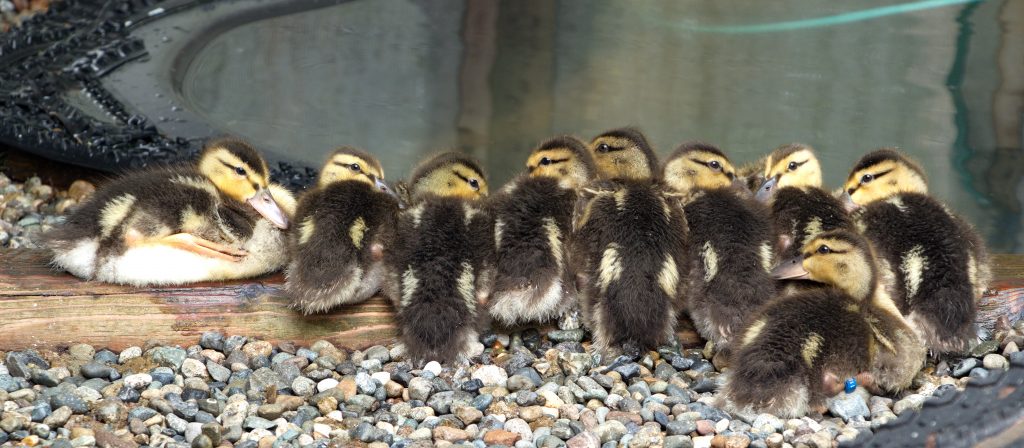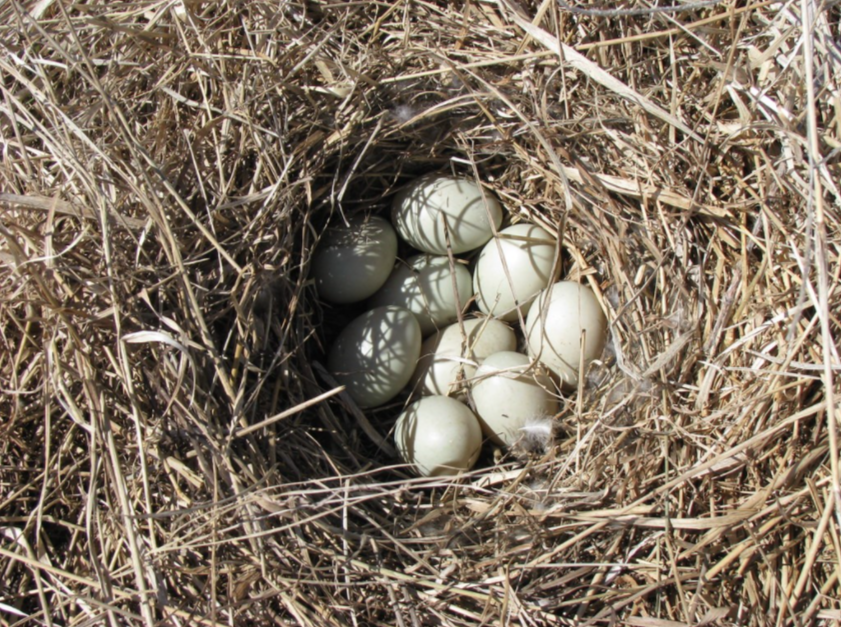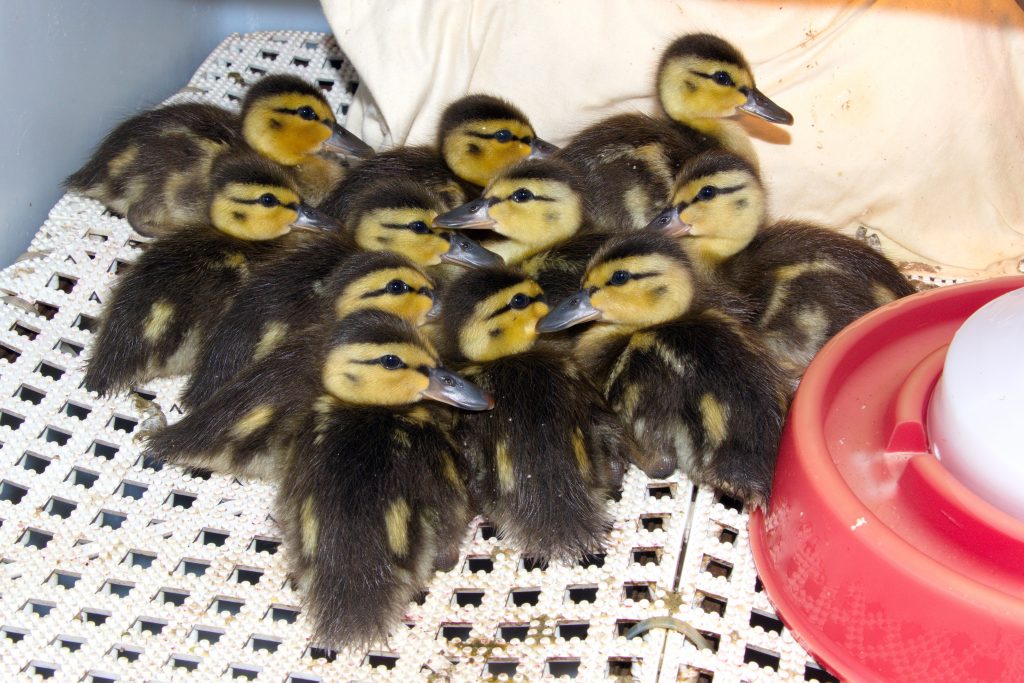Support Us
Since 1979 more than 140,000 animals have been treated by Wildlife Rescue.
Thanks to the support of individuals like you, Wildlife Rescue can provide a lifeline for animals in distress.
Spring is duckling season, and with that comes a lot of questions about what to do when little baby ducks show up in unexpected places. Get your questions answered with our quick and handy Duckling FAQ! If you still have any questions, please contact our Support Centre.

Like many bird species, the large and majestic Great Blue Herons are working away at nesting and laying eggs. While they’re not an uncommon sight around Vancouver, they are a species at risk in BC.
Despite their relatively large size, herons are extremely sensitive birds. The slightest human disturbance can cause a heron to completely abandon their nest. As herons nest in colonies of multiple families (also known as rooks), a group of herons abandoning a nest due to stress can be devastating.
What can you do to help? If you’ve noticed herons nesting near your home or favourite walking path, do your best to steer clear of the nest to prevent disturbing the birds. Keep an eye out for signs. Sometimes conservation officers will place them in the area to warn the public that a heron nest is nearby.
The above is especially true if you have a lovable canine friend. Dogs are a big disturbance for nesting herons, so be sure to keep your best friend close, on a leash, and well away from nesting sites on your daily walks this spring.
Your donations are critical to helping the local heron population! With your help, nests of orphaned baby herons can receive the care they need at Wildlife Rescue. Together, we can do our part to help these majestic, and sensitive, animals survive.

There are more babies on the way in spring than just birds! Coyotes are great at pest control, eating rats and mice, so it’s important to know how we can best share our environment with these tenacious wild animals.
Coyotes will form breeding pairs and begin having litters of puppies around this time of year. They are dedicated parents, and both males and females will stay with the litter. Coyotes are more visible at this time of year as they’ll be patrolling their territory with frequency. They might appear to act more aggressive, but in reality they’re just trying to keep their little ones safe. So, what can we do if we think there’s coyote activity in our neighbourhood?
Our friends at the Stanley Park Ecology Society have come up with the following guidelines for safe coexistence:
Most importantly, If you see a coyote, you can report the sighting to the Stanley Park Ecology Society here! This helps the conservation community know where activity is highest and can help keep people, pets and coyotes safe.

Now that spring is well on its way, many of us are looking to get started on the season’s gardening so that we can enjoy a beautiful outdoor space all summer. You can get your backyard ready for yourself and help wildlife at the same time this spring with these simple tips from the Wildlife Rescue team!
First, this weekend is looking like a great time to start trimming hedges and shrubs. Few species will have started nesting at this point, so you’re less at risk of disturbing a nest. Hummingbirds do settle down early, so be on the lookout for their little nests. Any cut branches you’ve left behind might then be snatched up to help build a comfortable home for other birds.
You may be tempted to keep going and start raking all those fallen leaves, but here’s a great excuse to put it off a little longer! Pollinators like bees and butterflies will overwinter under piles of insulating leaves. Wait until temperatures are consistently 10 degrees Celsius or higher before cleaning up to give these beneficial insects time to wake up for spring.
When it’s time to get planting, focus on native species for your balcony or yard. These species help feed hummingbirds and berry eaters, so your greenspace can support their foraging. As an added bonus, you’ll attract more wildlife visitors to your yard without needing to maintain a feeder.
In BC, plant native species, like…
As always, thank you for looking out for your local wildlife!
The spookiest night of the year is coming soon! While we here at Wildlife Rescue are big fans of all things that go bump in the night, we’d like to take a moment to help you make sure your moonlit rituals, haunted houses and sunken crypts are as safe for wildlife as possible!
Artificial Spider Webs
While artificial spider webs are a great way to add some creepy ambiance, they are a major hazard for wildlife. Every year we take in animals who have been entangled in these decorations. Sadly, many people discover these trapped birds, bats and squirrels when they are taking decorations down after Halloween and by that time it’s often far too late.
Treats
It’s not Halloween without Trick or Treating! Unfortunately chocolate and other things we humans find delicious are deadly to pets and wildlife, plus individually wrapped treats leave a lot of waste behind that can seriously injure animals.
Pumpkins
Carving a Jack o’ Lantern is a favourite activity for a lot of people to celebrate Halloween. A lot of hard work goes in to making those creepy grins. However, pumpkins can be a temptingly tasty treat for wildlife like deer or racoons. It might be tempting to try and dissuade animals from eating your pumpkins with chemicals or other deterrents, but this often leads to animals becoming seriously ill.
Fireworks
Fireworks are loud, disruptive and frightening to pets and wild animals alike. Not only that but launching them into the air can seriously injure or even kill flying birds and bats. Even the most diligent fireworks operator likely won’t be able to clean up all the refuse left behind from a fireworks display, and a lot of trash can be left behind for animals to find.

Here’s a fun idea for an event thanks to BC Bats. Organize a bat count! When the sun goes down bat activity is at its highest. Take yourself, your kids, some friends and your trick or treating candy to a quiet area near a bat roost and start counting!
To our valued Wildlife Rescue supporters,
As you may already know, cases of HPAI (Highly Pathogenic Avian Influenza) have been detected in BC. We want to let you know that Wildlife Rescue Association is aware of this risk and has taken action to keep staff, volunteers, and our feathered patients safe. We are continuing to monitor this situation, following the guidance of the Public Health Agency of Canada, and will adapt as needed to ensure the highest level of safety is assured.
For the most current guidance regarding wild birds, bird feeders, caring for domestic birds, and reporting sick or dead birds—please visit the official Government of Canada website at the link below.
Wildlife Rescue Association is not responsible for the surveillance of Avian Influenza in Canada. For the most up-to-date reports and information on the status of HPAI in Canada, please refer to the Government of Canada website at the link below.
Thank you for your continued support of our wildlife patients at this time!
Current research suggests that well-maintained bird feeders and hummingbird feeders are low-risk, but not no-risk, for transmitting many diseases including this virus. If you choose to keep a bird feeder or hummingbird feeder, please remember that this is an important responsibility. Clean and maintain your bird feeders regularly to ensure the safety and wellbeing of wildlife now, and year-round.
Backyard bird feeders, hummingbird feeders, and baths should be cleaned regularly using a weak solution of domestic bleach (10% sodium hypochlorite). Ensure they are well rinsed and completely dried before re-use. If you are not able to diligently maintain and clean your bird feeder, please consider removing it for the safety of your wildlife visitors.
Please note, this situation is evolving and this guidance may change. Always refer to the official Government of Canada website for the most current official guidance.
Additional information regarding bird feeders and bird baths is being provided by the BC SPCA.
Their advice is an extra step you can take to support wildlife in BC. For more information about this step, please refer to the BC SPCA website at the link below.
For the most current information and official guidance regarding this evolving situation, please always refer to the Government of Canada’s Avian Influenza Surveillance
Unlike songbirds, baby ducks and geese leave the nest almost immediately after birth, and will follow their mom closely. They already know how to find their own food, but still need their families for warmth and protection. Baby ducks and geese can go in water briefly, but because their feathers are not yet waterproof, they can quickly become hypothermic (chilled) if they remain in the water more than a few minutes. If you find a baby duck or goose alone, it is almost certainly just separated from its family.

If you find a Mallard nest with only a few eggs in it, allow the mother to finish laying all of her eggs (typically 12-13 total). Mallards lay one egg a day, so this will take up to 12-13 days. She will not start incubating her eggs (laying on them) until all eggs are laid, so finding a nest with only three or four eggs and no mother duck does not mean that the nest is abandoned.
If something does happen to the unfinished clutch of eggs, Mallard hens will make another attempt until they raise a successful brood.
Once all eggs are laid, she will rarely leave the nest apart from short breaks to feed and stretch her legs. About 28 days later the eggs hatch together. This takes about 24 hours.
Mallard eggs are unmarked creamy to grayish or greenish buff. There are typically 12-13 eggs per clutch.

Photo Credit: USFWS: https://www.flickr.com/photos/usfwsmtnprairie/11856952175
Once hatched, the ducklings will stay in the nest for at least 10 hours while they dry and get used to using their legs. Then, usually in the early morning, the female leads them to water. Bad weather may delay this, but the sooner the ducklings get to water to feed, the better their chances of survival. They cannot survive without their mother, and take 50-60 days before they fledge and become independent.

The mother duck may have been spooked away and has not returned. Keep the babies protected and wait from a nearby location to see if the mother returns. She will usually return within a half-hour if the area has become quiet again and the threat is gone. She is very protective of her babies and will not go far or stay away for very long. If the mother does not return to her babies within 1-hour, the ducklings should be rescued and brought to Wildlife Rescue.
Hypothermia will result if babies are in a pool for more than a few minutes. Mother will stay in the pool with them (to protect them) if they cannot get out and it appears as if she is voluntarily allowing them to swim. She will exit the pool as soon as the babies are given a means to get out of the water. Be sure to screen skimmer or filter openings that may trap helpless ducklings with suction.
Pool covers are an effective control for uninvited pool guests. They are also safer for other wildlife (baby birds) that may fall into it. Other measure to discourage ducks from pools include; floating alligators or beach balls (they must be moving continuously); sensor sprinklers or sprayers strategically placed; monofilament barriers (installed by professionals); music, radio or strobe lights activated by sensors. Some professional companies specialize in exclusion devices for wildlife.
Mallard ducks are federally protected, so moving the nest is illegal without a permit. It is unlawful for any person to capture, possess or relocate ducks (and other migratory birds) except by permit. We encourage you to let the ducks finish nesting. After the ducklings hatch and the family moves on, you can put up deterrents to prevent them from nesting there again.
Ducklings/ goslings can safely jump to the ground from buildings that are less than 2 stories high and if there is no barrier/edge higher than 12cm. If a family of ducks have nested on a building that is taller than 2 stories and/or there is a barrier higher than 12 cm it is best to contact our Support Centre. Wildlife Rescue has trained volunteers that can help with these rescues. Mother Mallards may not return to their ducklings if stressed so it is important to contact Wildlife Rescue first before attempting capture.
It’s normal for a female mallard not to eat for the entire incubation period – she fattens up beforehand to prepare. Leaving food or water out for the duck will only attract predators like raccoons or opossums, putting the nest in danger. Once the ducklings have hatched, feeding them unnatural food like bread can cause problems with their growing bones and feathers.
Always consider human safety first– never put yourself or other people in danger to help a family of ducks cross a road. You can help by waving at drivers to alert them to the birds. Ask passersby with pets or children to keep back. Keep a safe distance, and try to gently steer the birds in the direction of the closest pond, stream, river, or lake.
It may seem like a good idea in these situations to try to catch the family and move them to a safe spot, but this risks scaring off the mother and scattering the babies.
Remember that crossing roads is a fact of life for urban wild animals, and one of many skills babies need to learn from their parents.
Some rescues are best left to the experts, and duck families on multi-lane highways with barriers and heavy traffic may need help. Please contact the non-emergency police line to ask for assistance.
The Arctic outflow has impacted wildlife dramatically this season! With a record-breaking drop in temperature across the Lower Mainland, hummingbirds are coming into Wildlife Rescue Association (WRA) in record numbers with cold-induced injuries.
Hummingbirds – a crowd favourite, miniature acrobats that dart and dip, hunting for high-energy foods.
Although these tiny birds weigh less than a loonie (averaging between 3 and 6 grams), hummingbirds need to be almost constantly eating. Hummingbirds flap their wings 50 times or more per second in order to maintain their signature hovering flight. Undoubtedly, this requires an immense amount of energy. In order to fuel their flight, hummingbirds consume half their body weight in pure sugar every day!
Known to be special birds that spend much of their time in certain parts of British Columbia, Nighthawks are essential to our environment. Even though they might not be easy to find much of the time due to nocturnal habits, these birds contribute so much to our ecosystem. Unfortunately, they also need our help. Studies by the North American Breeding Bird Survey have revealed that Common Nighthawk populations decline at the rate of 4% a year in Canada, populations going through a steep annual decline since the 60s.